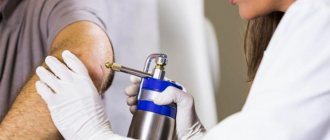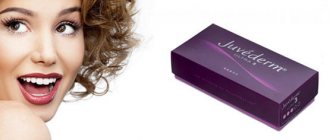The term papilloma refers to a group of various benign epithelial proliferations.
They can affect the appearance of the skin and the condition of the mucous membranes.
To remove papillomas, cauterization with various devices and medications is used.
Papilloma (condyloma) visually resembles a papilla attached to a narrow stalk.
The formation may be soft to the touch or have a dense structure.
In color - do not differ from the natural skin or be darker.
The localization of papillomas is varied.
Neoplasms affect the outer epidermis (facial skin, genitals, arms and legs).
So does the mucous membrane (vagina, cervix, colon, gastrointestinal tract).
In some cases, condylomas may form on the mucous membrane of the throat, which leads to difficulty breathing and voice disturbance.
The main cause of the formation of papillomas is HPV, a virus of the papillomavirus family, which includes about 170 strains.
HPV penetrates the skin or mucous membrane.
Mainly through small cracks or damage, and multiply inside cells.
HPV is transmitted by direct contact through affected areas of the skin or mucous membranes.
The most effective treatment for papillomas is their removal followed by therapy with antiviral and immunostimulating drugs.
There are a variety of methods for removing condylomas:
- laser
- surgical
- radio wave
- electric
- using low temperatures
Also, cauterization of papillomas can be carried out locally using medications (ointment or solution) that have a cytostatic effect.
Which therapy is suitable for the patient is decided on an individual basis.
The choice also depends on the nature of the warts and where they are located and how widely they have spread.
Cryodestruction of papillomas (cauterization with nitrogen)
Cryosurgery is used for a variety of benign, precancerous and malignant skin lesions.
Either as a primary or alternative form of treatment.
From a clinical point of view, the method is simple and safe.
The wide range of indications and relatively low cost of freezing make this method very popular in dermatological practice.
Cauterization of papillomas with nitrogen has a number of advantages:
- bloodless method (not accompanied by bleeding)
- does not provoke the development of scars and scar tissue
- in most cases no anesthesia is needed
- treatment can be single or multi-stage (repeated procedures are possible)
- low invasive method suitable for patients of all ages (most can be treated in outpatient clinics or day surgery centers)
- treatment of papillomas with nitrogen is safe and does not cause complications
- excellent cosmetic effect, minimal pain during the procedure
During cryodestruction, the active factor is liquid nitrogen.
The essence of the manipulation is to freeze the tumor at a temperature from -100°C to -180°C and then kill it.
Depending on the number of condylomas and their size, several procedures may be necessary.
In the first few hours after the manipulation, pronounced tissue swelling and redness are observed.
Over the next few days, symptoms become less severe.
After 7-10 days, complete death of the pathological tissue occurs.
Cryosurgery is not recommended for patients in the following cases:
- the presence of an acute infectious or inflammatory process (removal with nitrogen is carried out only after the disease has stopped)
- pathologies of internal organs that are under treatment
- hypersensitivity and intolerance to low temperatures
Disadvantages of cryodestruction:
- The skin takes a long time to recover; it will take about two weeks, sometimes more, until the tissue is completely healed
- nitrogen affects not only the pathologically altered area of the epithelium, but also the surrounding tissues, including
The downside is that a specialist cannot always determine the advisability of cryotherapy.
As a result, it is not possible to completely remove the formation and there is a need for surgical excision of the papilloma.
Cryodestruction is most widespread in gynecology.
Cauterization of papillomas in the vagina and cervix is considered the most gentle method of HPV treatment.
Does not have a negative effect on healthy areas of the mucosa.
Removal of tumors with nitrogen is the best option for nulliparous patients.
Radio wave excision of papillomas
Radio wave removal of papillomas is a method of non-contact surgery.
Based on the use of high frequency radio waves.
Radiosurgery is an atraumatic method of removing formations with simultaneous coagulation of soft tissues.
During the procedure, an optimal heat source with a low temperature of 4.0 MHz is used.
This technology allows you to simultaneously remove papillomas and coagulate surrounding tissue.
At the same time, preventing the development of bleeding, without causing burns, and also accelerating the regeneration process.
Cauterization of papilloma with radio waves has a number of advantages:
- Absence of pain during manipulation. Exposure of the epidermis to a high-frequency wave promotes coagulation of nerve fibers, blocking muscle spasms. Thus, the effect on sensitive receptors is eliminated, and the pain syndrome is relieved. If there is an increased pain threshold or psycho-emotional anxiety, the patient may be given an injection of an anesthetic drug.
- Minimal damage to non-pathologically altered tissues. The incision with a radio wave scalpel is carried out without pressure on the skin, thus, there is practically no impact on healthy tissue. In terms of this parameter, other methods of cauterization of condylomas are significantly inferior to the radio wave procedure.
- High regeneration capabilities. Simultaneously with the removal of the papilloma, the radio wave has a bacteriostatic effect on the wound, destroying all possible infectious microorganisms. For this reason, rapid healing of the epidermis and the absence of an inflammatory process are observed.
- No scar formation. When removing papillomas with a radio knife, the tumor is precisely and accurately cut off, while healthy tissue is not affected. This helps prevent the development of scar tissue and deep scars.
When radio wave treatment is contraindicated:
- the presence of acute inflammatory and infectious pathologies
- diseases of internal organs that are in the process of therapy
- the patient has a pacemaker (there is a risk of malfunctioning of the medical device)
If there is a contraindication to the methods described above, it is recommended to cauterize the papillomas with a laser.
The method is completely painless and does not require additional anesthesia.
The laser beam after cauterization of the papilloma does not provoke such consequences as the development of scar tissue or the formation of scars.
How to get rid of plantar warts?
What are warts?
Warts are benign skin growths caused by the human papillomavirus; this virus penetrates the skin and mucous membranes. The most common manifestation of HPV infection in humans is the manifestation of plantar warts. More than 150 subtypes of HPV are known in the world, some of them can be localized in certain areas of the body. HPV type 1 can primarily affect the feet and soles, resulting in plantar warts.
How do warts appear?
Typically, infection with HPV, which causes warts, occurs through direct contact with an infected area of skin, or through contaminated objects. Such violations of the protective function of the skin: cuts, abrasions, hangnails, dermatitis of various kinds, can contribute to the development of the disease. Warts manifest themselves symptomatically through growths on the skin, which cause discomfort and pain, both at rest and while walking, which greatly interferes with the life of a modern person.
How to cure plantar warts?
The most effective treatment method is to remove warts that have already appeared. Chemical destruction with salicylic acid-based preparations or removal with liquid nitrogen can be used. These methods are the most proven, accessible and effective, but other removal methods are also acceptable:
Laser burning. Using a medical laser, the resulting growth is removed in layers; local anesthesia can be used. The method causes the least trauma to the body and does not cause cosmetic defects in the area with the wart.
Electrocoagulation. Due to the impact of high-frequency current on an area of skin, the roots of the wart are burned out, but after the wound has healed, scarring and scarring may appear.
Surgical removal. Surgical removal of warts is used when the roots of the growth are deep. Radio wave surgery uses high-frequency radio waves (3.8 - 4.0 MHz), which completely get rid of the wart.
A method that has proven itself well in the treatment of plantar warts is cryodestruction. Carrying out this procedure over a diseased area of skin is extremely effective; due to the extremely low temperature of nitrogen, any organic formations will be destroyed. Cryodestruction has no contraindications; it does not require injections of anesthetics, which can cause dangerous allergic reactions. You can read more about the removal of plantar warts using cryodestruction in our article about cryodestruction.
The use of destruction with chemicals (salicylic acid) and the use of cryodestruction are the first methods for removing simple and plantar warts. Unfortunately, plantar warts can become resistant to the chosen treatment method, requiring repeat treatment in the future. It is worth remembering that even complete removal of warts does not lead to a cure for the HPV that causes them, so relapse is possible.
What are the advantages of these types of plantar wart removal?
Chemical destruction is a painless, bloodless method of removal with minimal side effects.
Cryodestruction is a method that does not require anesthesia, preliminary preparation and the procedure itself takes several minutes. By using cryodestruction, you choose a bloodless method for plantar wart removal, with minimal side effects, and rapid healing allows you to quickly return to a comfortable everyday life.
Radio wave removal - this method of surgical treatment allows you to completely get rid of the tumor in one procedure. Minimal trauma to the skin, ensures better wound healing.
Ways to prevent the spread and occurrence of plantar warts:
● Use only personal shoes and leather goods.
● Use replaceable shoes when visiting swimming pools, shared showers, locker rooms, and baths.
● Use personal hygiene products when processing, cleaning, trimming nails and foot skin.
● Take care of the skin of your hands and feet, avoid excess skin moisture, damage, and prevent dryness and cracks.
Cauterization of papillomas with iodine
Cauterization of papillomas with iodine is the most accessible and cheapest method of eliminating formations.
Used in the presence of small growths.
As a rule, iodine is not used in its pure form, since it cannot have the desired effect on its own.
When removing small formations, 5% iodine is mixed with salicylic acid (2% solution).
In a ratio of 1:2 (one part iodine, two parts salicylic acid).
Apply baby cream or Vaseline to the area around the papilloma.
Next, using a cotton swab or ear swab, carefully apply the resulting mixture.
Salicylic acid has a softening effect, and iodine cauterizes and at the same time carries out coagulation.
Such treatment has no contraindications, except for the removal of papillomas that are located on the mucous membrane and individual intolerance to the components.
Cauterization of papillomas with iodine is relevant for neoplasms on the neck, face, and genital area that are not in contact with the mucous membranes.
But it is necessary to take into account that the procedure will not be able to completely eliminate the formation the first time.
As a rule, this therapy lasts for several weeks and even months.
What should I do? To remove or not to remove warts at home?
I understand perfectly well that with this article I cannot prevent the sale of such drugs without a prescription, that is, without a doctor’s examination. In general, I am not against removing warts using these methods, but one extremely important condition must be met.
You can burn a wart with anything, under any conditions, but only after an in-person examination by an oncologist or dermatologist, optimally with dermatoscopy. The fact that you have a wart on your skin, and not melanoma or cancer, must be confirmed by a specialized specialist. If there is the slightest doubt about the diagnosis, the wart should be removed with histological examination.
Cauterization of condylomas (papillomas) with potassium permanganate
Potassium permanganate is a potassium salt from the manganese subgroup (HMnO4).
The molecular formula of potassium permanganate is KMnO4.
At room temperature, the salt is present as a red-violet, shiny metallic crystalline solid.
The crystals are moderately soluble in water.
Even in low concentrations they lead to an intense violet color of the liquid, for which the permanganate anion is responsible.
Potassium permanganate solution is used as an astringent and disinfectant.
For external use on the skin, including mycoses, herpes zoster.
In emergency medicine, a 0.1% solution of potassium permanganate is used to lavage the stomach in case of poisoning due to ingestion of oxidized toxins.
Cauterization of papilloma with potassium permanganate is a popular method for removing tumors at home.
For the procedure, prepare a saturated dark purple solution.
They need to treat the formation several times a day until the papilloma completely disappears.
Under the influence of potassium permanganate, condylomas become dark in color, dry out and fall off.
The solution must be applied with extreme caution, avoiding contact with healthy tissue.
Cauterization of papillomas with potassium permanganate is also possible in intimate places.
But provided that the neoplasms do not come into contact with the mucous membranes.
Cauterization of papillomas with celandine is also popular.
To do this, use the juice of the plant, which is applied to the condyloma or wart.
For small growths, celandine is effective.
But treatment in this way can take several months.
As an alternative to the plant, you can use Supercelandine to cauterize papillomas.
This is an extract sold in any pharmacy.
Cauterization of papillomas at home should be carried out only after consultation with a doctor.
The problem of self-diagnosis of skin tumors
From the previous section it is clear that drugs for the treatment of warts are divided into 3 groups:
- Acids, alkalis and other toxic substances.
- Substances of plant origin that are written in the composition are most likely a distraction.
- Drugs with proven effectiveness in the treatment of warts.
There are drugs with proven effectiveness in the treatment of warts. What is the problem?
-So what's the problem? - you ask. -We go to the pharmacy, buy the right drug and treat our warts without any doctors there.
“The problem is that you don’t know whether you have a wart or not,” I will answer.
The main difficulty lies in the wording of the question itself. The question you need to ask is not “how to effectively remove warts at home?”
A much better question would be: “How do I know that I have a wart and not skin cancer or melanoma?”
Repeatedly, patients came to see me and called pigmented nevi warts or papillomas. It is quite obvious to me that in most cases a person without specialized education will not be able to distinguish melanoma or skin cancer from a wart.
In the “indications” section for all these drugs it is written “warts, less often keratomas”. Some particularly daring authors also add moles to this pile. The manufacturer of the drug believes that the patient himself is able to make the correct diagnosis. My experience suggests that without a histological examination, even a doctor cannot always accurately determine the nature of a skin tumor by eye.
In the photo - the author with a dermatoscope
Pharmaceutical preparations for cauterization of papillomas
In the treatment of papillomas, in particular genital ones, it is important that both partners undergo therapy.
Otherwise, there is a risk of continuous cross-infection.
There is no “best” treatment for genital warts.
Therapy depends on the location and volume of papillomas, as well as on the preference of the doctor and, of course, also on the request of the patient.
The following effective treatment options are available to treat genital warts:
- topical medications such as creams, ointments or solutions
- surgical removal (coagulation, radio wave, nitrogen cauterization)
Podophyllotoxin cream or solution for cauterizing papillomas
Podophyllotoxinum is a medicine obtained from the root of Podophyllum thyroid.
More often it can be found on sale in the form of a cream for external use.
The drug is applied to papillomas twice a day for three days, followed by a four-day break.
If the procedure does not give the desired result, the manipulation can be repeated after four to five days.
This cycle of procedures can be repeated 2-3 times, but no more than four.
Podophyllotoxin is especially recommended for genital warts that have not yet been treated.
However, for larger papillomas, the size of which is 2 cm or more, podophyllotoxin is not suitable, since the maximum daily dose is 0.5 mg of the substance.
Additionally, Podophyllotoxin should not be used to treat genital warts located in the vagina or anus.
About half of the patients using the subphyllotoxin preparation noted a slight burning sensation.
Redness of the skin may occur as a side effect.
Podophyllotoxin is a toxin that blocks the division of pathological cells.
Therefore, it is strictly prohibited for the treatment of children, pregnant and lactating women.
Podophyllotoxin, a product for cauterizing papillomas, can be purchased at a pharmacy without a doctor's prescription.
Chemical coagulation
Silver nitrate
Silver nitrate used to be widely known, primarily as a drug used in newborns to prevent conjunctivitis. But then it was replaced by antibiotics, and was later used to cauterize purulent and umbilical granulomas, for nosebleeds, for calluses and warts. This method is now more widely used in England, where pencil applicators containing 95% silver nitrate are available for sale without a prescription. In the United States, however, the Food and Drug Administration has warned consumers that all over-the-counter products containing colloidal silver or silver salts for internal or external use are not safe. The application of silver nitrate must be done with caution to avoid excessive burns and permanent staining of the tissue. The clinical effectiveness of the method is assessed as average and amounts to 43%, however, a month after the end of therapy, recovery was observed in another 26%. Silver nitrate was applied three times, with a break of three days between each application. Treatment in the placebo group resulted in 11% recovery and 14% improvement.
Salicylic acid
Salicylic acid is the treatment that most patients choose first as it is the least expensive. This is keratolytic therapy, i.e. accompanied by the destruction of the epidermis infected with the virus, while the irritating effect of salicylic acid leads to an increase in the local immune response. Salicylic acid is used in concentrations ranging from 10 to 60%. Over-the-counter preparations available include 17% salicylic acid in cream form and 40% patch. The main advantages of salicylic acid: ease of use, economic benefits, minor pain. The disadvantage of this method is its duration. The main side effect is contact dermatitis. Warts are soaked in warm water for 5 minutes, then surface hyperkeratosis is removed using pumice and salicylic acid is applied. Salicylic acid in the form of a cream is changed every day, in the form of a patch every 48 hours. Patients (especially children) usually accept this type of treatment well. A review of 13 different studies on the effectiveness of salicylic acid in concentrations ranging from 15% to 60% (more researchers used salicylic acid from 15% to 26%, sometimes in combination with lactic acid) found the effectiveness of this treatment to be 75%, compared with 48 % in the placebo group. Monotherapy with 5-fluorouracil, glutaraldehyde, cryotherapy, or podophyllin treatment was less effective than salicylic acid treatment. Plantar warts are especially suitable for treatment with this method, in contrast to warts on the face, the treatment of which is complicated by irritation and potentially dangerous scarring.
Cantharidin
Cantharidin (cantharidic acid anhydride) is obtained from the gonads of the beetle known as the Spanish fly. The use of this drug leads to epidermal cell necrosis, acantholysis, which is clinically manifested by the formation of a bladder. As of 1992, the drug is no longer available in the United States, but can still be purchased in Canada. Method of use: cantharidin, like salicylic acid, is applied to a wart that has previously been cleared of hyperkeratosis and covered with a band-aid for 24 hours. A blister forms at the site of the wart, which will heal in 1 to 2 weeks. Cantharidin can be reapplied after 1-3 weeks. The effectiveness of treatment for both plantar and periungual warts is quite high and amounts to 80%. The advantages of the method are the absence of pain and scarring. Unfortunately, no randomized, placebo-controlled trials have been conducted for the treatment of warts vulgaris with cantharidin.
Additional Information:
- Traditional and alternative treatments
- Surgical excision
- Cryotherapy
- Laser destruction methods
- Photodynamic therapy
- Therapy aimed at destroying the virus
- Antimitotic therapy
- Immunotropic therapy
Trichloroacetic acid for cauterization of papillomas
Trichloroacetic acid is a liquid for cauterizing papillomas.
Stops the development of infected cells and prevents their further reproduction.
Trichloroacetic acid is applied by a doctor with a cotton swab to warts, papillomas/condylomas.
This treatment method is suitable for small, soft genital warts in the mucous membrane area (in the vagina).
Among the disadvantages of the method, it is worth noting burning and pain after applying the solution.
The advantage is the elimination of formations without tissue scarring.
Acid can only be used in very small quantities.
Excessive use requires neutralization with sodium bicarbonate.
Due to the potentially high risk of misuse, trichloroacetic acid should only be used by a physician in an outpatient setting.
Today, this method of therapy is rarely used; it has been replaced by more modern and gentle therapeutic methods.
An analogue of trichloroacetic acid is Solkovagin, which is also used to cauterize papillomas and warts.
The second, more expensive drug is Solcoderm, which can cauterize papillomas in intimate places.
Imiquimod cream for cauterization of papillomas
Imiquimod does not have a direct antiviral effect.
The cream modifies the immune response by activating messenger substances.
Such as interferons and cytokines, which play a role in cell communication and can influence cell function.
The product can also be found under the name Keravort.
Local therapy is carried out three times a week, the drug is applied to the papilloma before bedtime.
The maximum duration of use of the drug is 4 months.
The advantage of Imiquimod cream is the low incidence of recurrent genital warts (less than 20% as a result of a sustained immune response).
Imiquimod should not be used for genital papillomas in the vagina, cervix, lining of the glans penis or anus.










